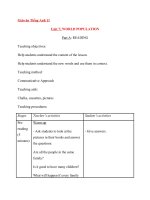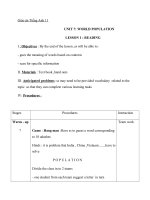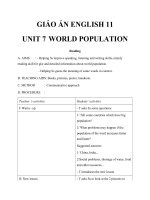Giáo án Tiếng Anh 11 Unit 7: World population
Bạn đang xem bản rút gọn của tài liệu. Xem và tải ngay bản đầy đủ của tài liệu tại đây (138.73 KB, 30 trang )
Giáo án Tiếng Anh 11
Unit 7: WORLD POPULATION
Part A: READING
Teaching objectives:
Help students understand the content of the lesson.
Help students understand the new words and use them in context.
Teaching method:
Communicative Approach
Teaching aids:
Chalks, cassettes, pictures
Teaching procedures:
Stages
Teacher’s activities
Pre-
Warm-up
reading
(5
minutes)
- Ask students to look at the
pictures in their books and answer
the questions:
Are all the people in the same
family?
Is it good to have many children?
What will happen if every family
Student’s activities
- Give answers.
have a lot of children?
While-
- Ask students to read the text
reading
silently.
(33
- Introduce some new words.
minutes)
B.C: Before Christ
- Read silently.
- Listen and take notes.
A.D: Anno Domini
to limit: to restrict
to freeze – froze – frozen
population (n)
→ population growth
→ population explosion
support (v, n)
limit (n,v)
decrease ≠ increase
Task 1: Ask students to read the
- Pair work (Task 1).
text again and do Task 1.
Stages
Teacher’s activities
Student’s activities
- Give feedback.
- Give answers.
While-
Suggested answers
reading
Although
(33
minutes)
method
increases
resources
figures
limit
international
control
Task 2:
- Ask students to do Task 2 (group
- Group work (Task 2)
work).
- Ask the representative of each
- Give the answers.
group to give oral answers and
write them on the board.
- Give feedback.
Suggested answers
- Take notes.
It was 10 million people in 10,000
B.C, 625 million people in 1750,
1,300 million people in 1850,
2,510 million people in 1950,
4,760 million people in 1985 and
6,6 billion people in 2000.
The population of the world is
expected to be 7 billion.
Some scientists say it can, but
others say it can’t.
No, they don’t.
They can’t limit the size of their
family because they know of no
safe way to have fewer children.
Task 1: (books closed)
- Work in pairs.
Post-
- Perform in front of the class.
reading
The population of the world has
(7
been (1) ____________ faster.
minutes)
It’s time government and
international organizations (2)
____________ something to (3)
____________ the problem.
Stages
Teacher’s activities
Post-
Task 2:
Student’s activities
reading
(7
minutes)
- Ask students to find out five
world largest countries in
population, say where they are and
- Work in pairs.
- Do as suggested.
which is the richest and which is
the poorest country.
- Give feedback.
- Give answers.
Suggested answers
Five world largest countries in
population:
China, India, Russia, the
USA, and Indonesia.
Location:
China, India and Indonesia
are in Asia, Russia is in Europe,
and the USA is in Latin America.
The richest country is the USA and
the poorest country may be India.
Homework
Write down the questions and the answers in the notebooks.
Learn the new words and questions by heart.
Prepare in advance Part B - Speaking.
Unit 7: WORLD POPULATION
Part B: SPEAKING
Teaching objectives:
Help students improve their speaking skill. Students can discuss the topic (some
causes of population explosion, the problems it has caused and the solutions)
Teaching method:
Communicative approach
Teaching aids:
Pictures, chalks, cassettes, textbook.
Teaching procedures:
Stages
Teacher’s activities
Students’activities
Pre-speaking
Warm –up:
- Teacher asks students some
questions:
- Give answers
Is population explosion a big
problem nowadays?
What are some causes of
population explosion?
- Give answers
- Look at Task 1 and give your
opinion.
- Introduce Task 1 and give the
meaning of some news words (if
necessary )
Task 1
- die at birth
- be aware of
- religion
- Work in pairs
While – Speaking
- insurance
- Give their
presentation.
While – Speaking
- Ask students to do Task 1 in
pairs.
- Give feedback and correct
mistakes if necessary.
Suggested answers
People are not properly
educated. There are a lot of
people especially in remote areas
who have little education. So
they aren’t interested in news or
what is happening around them
or in the world.
People aren’t aware of
population explosion. They don’t
think that all big families will
lead to explosion.
People believe that having many
- Pair work
children means happiness.
Many people believe that having
a large family is a form of
insurance. They think that when
they are old, their children will
look after them.
Fewer children die at birth
thanks to medical care and
advanced technology in
medicine.
Religion doesn’t encourage
people to have fewer children.
Task 2
While – Speaking
- Ask students to do Task 2 in
pairs .
Example
People in these countries have
poor living conditions.
- Perform in front of
class.
- Group work
- Ask some pairs to present their
ideas in front of class.
- Give remarks
Some suggestions
People in these countries have
poor living conditions or lowliving standard.
There isn’t enough food for all
- Perform in front of
people in these countries.
class.
These countries lack schools,
teachers and hospitals.
Post-speaking
Task 3
- Ask students to do Task 3
(group work )
Example
In order to control the population
growth, the government should
encourage people to use birth
control methods.
- Ask students to report in front
of class.
- Give remarks.
Some suggestions
In order to control the population
growth, the government should
do these things:
The government should raise an
awareness of the problems of
overpopulation.
The government should
implement reward and
punishment policies, carry out
population education
programmes and family planning
Problems Solutions
-
-
-
-
-
-
programmes.
The government should
encourage people to use birth
control methods.
Task 4
- Ask students to complete the
table.
- Ask some students to talk about
the problems of overpopulation
and solutions in front of the
class.
Homework
Review part B .
Prepare part C – Listening.
Unit 7: WORLD POPULATION
Part C: LISTENING
Teaching objectives:
Help students improve their listening skill.
Help students understand the interview and do Tasks 1& 2.
Help students learn the vocabulary related to the topic.
Help students be able to summarize the content of the interview.
Teaching method:
Communicative Approach
Teaching aids:
Chalks, cassettes, pictures, overhead projector
Teaching procedures:
Stages
Teacher’s activities
Students’ activities
Pre-
Warm up
- Work in pairs.
listening
(8
- Ask students to work in pairs and discuss the
following questions:
minutes)
Do you think that our world are
overpopulated? (T can use pictures)
What is the population of the world?
- Ask students to repeat the provided words.
Latin America
- Listen and repeat in
chorus.
developing countries
improvement
particularly
punishment
shortage
inexpensive
rank
generation
Whilelistening
(27
minutes)
Task 1
- Ask students to read Task 1 silently.
- Read Task 1 silently.
Teacher’s activities
Students’ activities
- Ask students to listen to the interview
- Listen and do Task
(twice) and do Task 1.
1.
- Give feedback.
- Give answers.
Suggested answers
A
D
C
D
A
C
Task 2
- Ask students to read the questions in Task 2
- Read Task 2 silently.
silently.
- Ask them to listen to the interview again and - Listen and do Task
do Task 2.
2.
- Ask some students to write the answers on
- Look at the answers
the board.
on the board and give
feedback.
- Give feedback.
Suggested answers
According to experts, by the year 2015, the
population of the world will be over 7 billion.
He said that the population growth rates in
some parts of the world are not the same. The
population grows more quickly in some parts
of the world than others.
According to the expert, the reason for a fall
in the death rates is the improvement of public
health services and medical care.
The problem (which) population explosion
causes to the world, particularly to developing
countries are shortage of food, lack of
hospitals and schools, illiteracy, and poor
living conditions.
The expert offered four solutions. They are
to educate people and make them aware of the
danger of having more children
to provide safe, inexpensive birth-control
methods
to strictly implement a family planning policy,
and
to exercise strict and fair reward and
punishment policies.
Stages
Postlistening
(10
Teacher’s activities
Students’ activities
minute)
- Let students listen again.
- Listen again.
- Ask students to work in groups and
- Work in groups and
summarize the main idea of the passage.
do as suggested.
(Teacher can help students by giving them
some questions if necessary)
What is the interview about?
Table-filling
Population explosion
Reasons
Problems
Solutions
-
-
-
-
-
-
-
-
-
………… …………….. ………….
- Give feedback.
- Give performance in
front of class.
Homework
Practice listening at home.
Write Task 2 in the notebook.
Prepare Part D – Writing (page 86).
Unit 7: WORLD POPULATION
Part D: WRITING
Teaching objectives:
Describing information in a chart.
Teaching method:
Communicative approach
Teaching aids:
Chalks, textbook, letter
Teaching procedures:
Stages
Teacher’s activities
Students’ activities
Warm up
What continent has the largest population?
- Give answers.
The distribution of world population is not
the same in every region, is it?
Pre-writing
- Look at the chart and describe the
information in the chart.
- Explain some new words:
- Read silently.
unevenly
Whilewriting
account for
region
distribute – distribution
- Ask student to write a paragraph of 100 -
- Practice writing
120 words to describe the information in the
(group work).
chart.
- Write on the board.
- Ask the representative of each group to
write the paragraph on the board.
- Give correction and remarks.
Suggested paragraph
The chart shows the distribution of world
While-
population by region. It can be seen from the
writing
chart that the world population is distributed
unevenly in the South-East Asia. It accounts
for 58% of the world population. Especially,
the population of East Asia is more than
double the population of Africa. The
- Listen and take
notes.
population of Northern American is nearly
half of the population of Africa. In
comparison with the other region, the Ocean
ranks last, about 2%. Finally the population
of Latin America is 2% more than the one of
Northern American, about 8%.
- Ask student to repeat what they write (look
Post-writing
at the chart).
Homework
Review Part D.
Prepare in advance Part E (Language Focus).
- Individual
Unit 7: WORLD POPULATION
Part E: LANGUAGE FOCUS
Teaching objectives:
* Pronunciation: /kl/ ; /él/; /kr/ ; /ér/ ; /kw/
* Grammar: .Conditional types 1 and 2 (revision)
.Conditional type 3 (revision)
.Conditional in reported speech
Teaching method:
Communicative Approach
Teaching aids:
Chalks, pictures
Teaching procedures
Stage
Teacher’s activities
Students’
activities
A. Pronunciation
Pre-
1.Warm up
pronunciation
(3 minutes)
- Read 5 words (class, glass, crash, green,
queen).
- Ask students to write down the words.
- Correct and introduce the lesson.
While-
- Have students listen and repeat the
- Listen and
pronunciation sounds: /kl/ ; /él/; /kr/ ; /ér/ ; /kw/
repeat in
(7 minutes)
chorus.
- Have students read the sentences provided.
- Listen and
repeat in
chorus.
Pre-grammar
(7 minutes)
B. Grammar:
- Ask students to make complete sentences,
using the cues.
1. If / rain / tomorrow / we / picnic
2. If / I / you / I / him / advise.
- Do as
suggested.
3. If / he / exam / last year / parents
/disappointed.
- Correct and introduce language focus.
- Listen and
take notes.
Suggested answers
While-
1. If it rains tomorrow, we won’t have a
grammar
picnic.
(21 minutes)
2. If I were you, I would advise him.
3. If he had passed the exam last year, his
parents wouldn’t have been disappointed.
1.Conditional sentences
Ex1: If it doesn’t rain, I (come) ________ to
see you.
If it doesn’t rain, I’ll/ will come to see you.
Ex2
a/ If it didn’t rain, I (come) ________ to see
you.
If it didn’t rain, I’d/would come to see you.
b/ If I were you, I (not, buy) ________ that
coat.
If I were you, I wouldn’t buy that coat.
Ex3: If he (listen) _______ to me, he
wouldn’t have failed the exams.
If he had listened to me, he wouldn’t have
TYPE
IF-CLAUSE
MAIN CLAUSE
1
SIMPLE
SIMPLE
PRESENT
FUTURE (CAN/
MAY/MUST/
SHOULD/IMPE
RA-TIVE)
2
3
PAST
WOULD/COUL
SUBJUNCTI
D/MIGHT+
VE (BE
BARE
WERE)
INFINITIVE
PAST
WOULD/COUL
PERFECT
D MIGHT
+HAVE+PAST
PARTICIPLE
failed the exams.









